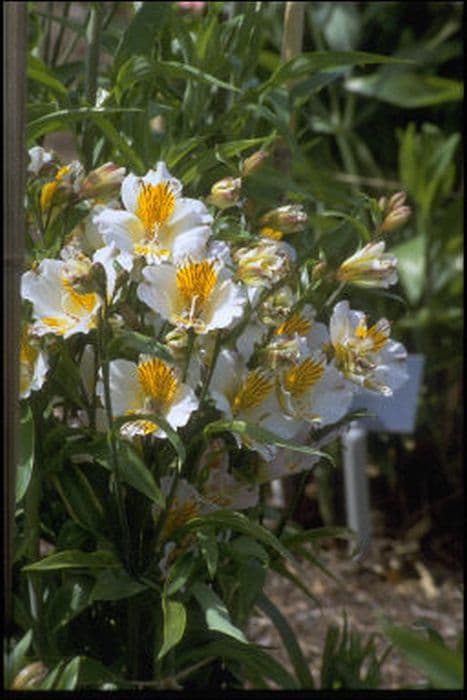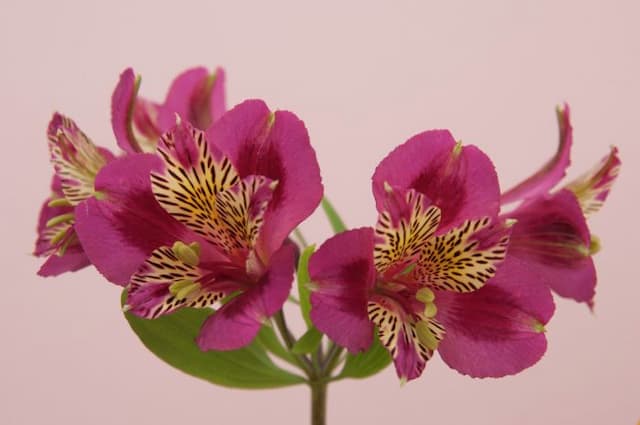Peruvian Lily Alstroemeria Inticancha White Pink Blush = 'Tesblushin' (PBR) (Inticancha Series)
![Peruvian lily [Inticancha White Pink Blush]](/_next/image?url=https%3A%2F%2Fplants-admin.emdemapps.com%2Fimages%2Fplants%2F%2Fimages%2F604b538014919.png&w=3840&q=75)
ABOUT
Alstroemeria, commonly known as the Peruvian lily or lily of the Incas, Inticancha White Pink Blush 'Tesblushin' is a striking variety that features a captivating blend of colors. The petals of this particular cultivar display a soft, creamy white base that is delicately flushed with a pink blush, giving it a very gentle and romantic feel. The inner segments of the petals may have speckled or streaked patterns with hints of yellow or darker pink, while the central parts of the flowers often have a contrasting tone, which can attractively emphasize the blush of the petals. The leaves of the Alstroemeria 'Tesblushin' are typically narrow and lance-shaped, presenting a lush green that provides a lovely backdrop for the flowers. The plant produces multiple stems that bear clusters of these eye-catching blooms. Furthermore, the floral arrangement is usually in the form of an umbel, meaning that several flowers branch out from a central point at the top of each stem, creating a full and appealing display. The Inticancha series is noted for breeding improvements, focusing on plants that offer long-lasting flowers and an extended blooming period, which means the 'Tesblushin' not only enriches gardens with its delicate beauty but also adds enduring color over the growing season. Its exotic look and impressive flower production make it an appealing choice for ornamental purposes in mixed borders, patio containers, and as cut flowers to enjoy indoors.
About this plant
 Names
NamesFamily
Alstroemeriaceae
Synonyms
Peruvian Lily, Lily of the Incas, Inticancha Alstroemeria, Inticancha White Pink Blush
Common names
Alstroemeria Inticancha White Pink Blush = 'Tesblushin' (PBR) (Inticancha Series).
 Toxicity
ToxicityTo humans
The plant commonly known as Peruvian Lily is not considered highly toxic to humans. However, like many plants, it may cause mild irritation if ingested, potentially resulting in nausea, vomiting, or diarrhea. It's important to avoid consuming any part of this plant and to keep it out of reach of small children who might inadvertently ingest it.
To pets
Peruvian Lily can be toxic to pets, particularly cats. If ingested, it may cause gastrointestinal upset, including vomiting, diarrhea, and abdominal pain. In some cases, it might also lead to mild dermatitis if pets come into contact with the sap. If you suspect your pet has ingested this plant, it is advised to consult a veterinarian.
 Characteristics
CharacteristicsLife cycle
Perennials
Foliage type
Evergreen
Color of leaves
Green
Flower color
Mixed
Height
1-2 feet (30-60 cm)
Spread
1-2 feet (30-60 cm)
Plant type
Herb
Hardiness zones
7
Native area
South America
Benefits
 General Benefits
General Benefits- Long Flowering Period: Produces blooms for an extended period, often from late spring to late fall.
- Attractive Flowers: Offers striking two-tone flowers with a white and pink blush that add visual appeal to any garden.
- Compact Growth: Ideal for small gardens or container planting due to its compact and well-branched growth habit.
- Low Maintenance: Requires minimal pruning and care once established, making it suitable for novice gardeners.
- Drought Tolerance: Once established, it can withstand periods of dryness, reducing the need for frequent watering.
- Cut Flower: Its long-lasting blooms are excellent for use in cut flower arrangements, providing color and beauty indoors.
- Attracts Pollinators: The blooms attract bees and butterflies, which are beneficial for pollinating your garden's plants.
- Hardy Plant: Displays resistance to many diseases and pests, ensuring its longevity and reducing the need for chemical treatments.
- Versatile Planting Options: Works well in mixed borders, pots, or as a stand-alone feature in the landscape.
 Medical Properties
Medical PropertiesThis plant is not used for medical purposes.
 Air-purifying Qualities
Air-purifying QualitiesThis plant is not specifically known for air purifying qualities.
 Other Uses
Other Uses- As a drawing or painting subject: Alstroemeria, with its intricate patterns and vibrant colors, can be an inspiring subject for botanical artists and hobby painters looking to capture its beauty on canvas.
- Photography: Due to their striking appearance, Alstroemerias are popular among photographers, particularly for macro photography, to showcase the details of their petals and color gradients.
- Educational tool: Horticulture and botany teachers may use Alstroemeria plants to educate students about plant biology, hybridization, and the care of perennials.
- Themed events and weddings: The Alstroemeria's elegant appearance makes it suitable for creating themed decorations, often used in wedding bouquets and table arrangements for a romantic ambiance.
- Dye production: The rich colors of Alstroemeria petals might be used in the natural dyeing process for fabrics or artisanal crafts.
- Pressing and scrapbooking: Alstroemeria flowers can be pressed and preserved to create beautiful additions to scrapbooks or other crafts.
- Seasonal decorations: Fresh or dried Alstroemeria flowers can be incorporated into wreaths or centerpieces for holidays and seasonal displays.
- Garden design: Alstroemeria can be used in garden design to provide a contrasting texture or color alongside other plants, or as a border plant for a pop of color.
- Flower arranging workshops: Alstroemeria is a popular choice for floristry workshops given its durability and versatile appearance, making it ideal for teaching different arrangement styles.
- Fragrance extraction: Although not as common as other flowers, the Alstroemeria's subtle scent could potentially be used in creating perfumes or scented products.
Interesting Facts
 Feng Shui
Feng ShuiThe Peruvian Lily is not used in Feng Shui practice.
 Zodiac Sign Compitability
Zodiac Sign CompitabilityThe Peruvian Lily is not used in astrology practice.
 Plant Symbolism
Plant Symbolism- Friendship: Alstroemeria, often called the Peruvian Lily or Lily of the Incas, is commonly associated with deep bonds of friendship, due to its interwoven leaves which symbolize the intertwining of relationships.
- Devotion and Loyalty: The Peruvian Lily is symbolic of a committed and loyal relationship, reflecting the idea of mutual support and enduring connections.
- Wealth and Prosperity: Many cultures view the abundance of blooms and long-lasting nature of the Peruvian Lily as a sign of wealth and the ability to create a stable future.
- Achievement and Success: Because the Alstroemeria blooms with multiple flowers on each stem, it can represent striving for achievement and the culmination of successes.
- Mutual Support: The twisted leaves of the Peruvian Lily, which grow together and symbolize intertwined lives, speak to the idea of mutual support between friends or partners.
 Water
WaterThe Peruvian Lily should be watered deeply once the top inch of soil feels dry to the touch, which typically equates to watering once a week. Adjust the frequency to account for rainfall and changes in temperature, with more frequent watering needed during hot, dry spells. Generally, using about 1 to 1.5 gallons of water per plant for each watering should suffice, ensuring that the water penetrates the soil deeply to promote healthy root growth. In the winter months or during cooler climates, watering can be reduced as the plant's growth slows down.
 Light
LightPeruvian Lilies thrive in full sun to partial shade conditions. The ideal spot for them is where they will receive at least 6 hours of sunlight daily, preferably morning sun with some afternoon shade in hotter climates. Avoid placing them in deep shade as this can result in fewer blooms and leggy growth.
 Temperature
TemperatureThe Peruvian Lily does well in a wide range of temperatures, tolerating a minimum of about 25 degrees Fahrenheit and a maximum of 80 degrees Fahrenheit. The ideal temperature range for vigorous growth and flowering is between 65 and 75 degrees Fahrenheit. They may require protection if temperatures drop significantly below freezing.
 Pruning
PruningPruning the Peruvian Lily is important for encouraging bushier growth and more blooms. After the flowers fade, cut back the entire flower stalk at the base to promote more flowering. Pruning should be done as needed throughout the bloom season, typically from spring through fall.
 Cleaning
CleaningAs needed
 Soil
SoilFor the Princess Lily, the ideal soil mix should be well-draining and fertile, with a mix of peat, perlite, and compost to provide a rich base. The soil pH should be slightly acidic to neutral, ranging from 6.0 to 7.0, to facilitate optimal growth and flower production.
 Repotting
RepottingPrincess Lilies should be repotted approximately every two years or when the root system has outgrown the current container. This usually helps to refresh the soil and provide room for continued growth.
 Humidity & Misting
Humidity & MistingPrincess Lilies thrive best in moderate to high humidity levels, ideally between 40% to 60%. Consistently high humidity helps to mimic the plant's natural environment and supports its overall health.
 Suitable locations
Suitable locationsIndoor
Place in bright, indirect light and maintain even moisture.
Outdoor
Plant in partial sun, sheltered from harsh winds.
Hardiness zone
7-10 USDA
 Life cycle
Life cycleThe Alstroemeria Inticancha White Pink Blush, commonly known as Peruvian Lily or Lily of the Incas, begins its life cycle as a dormant tuberous rhizome planted in early spring. Upon experiencing favourable conditions of temperature and moisture, it germinates and sprouts, leading to the development of roots and shoots. The plant then enters its vegetative growth phase, producing foliage and stems in preparation for flowering. Flowering occurs in late spring or early summer, displaying the characteristic white and pink blush blooms that attract pollinators for sexual reproduction. After pollination, seeds may develop and eventually, if conditions allow, disperse to produce new plants, completing the sexual life cycle. The plant can also spread asexually through the division of rhizomes, ensuring its persistence in the garden or natural environment.
 Propogation
PropogationPropogation time
Spring-Early Summer
The most popular method of propagation for the Alstroemeria, commonly known as Peruvian Lily or Lily of the Incas, is through division. This is usually done in the spring, just before the growing season begins, to allow the divided plants time to establish themselves. To propagate by division, carefully dig up the entire plant, making sure to keep a good amount of soil around the roots. Gently tease apart the clump of roots into smaller sections, ensuring that each new section has several shoots and a healthy portion of roots. These divisions can then be replanted immediately at the same depth they were growing before, spaced about 12 inches (approximately 30 centimeters) apart to give each new plant enough space to grow. Adequate watering is essential after replanting to help the divisions settle in and reduce transplant shock.





![Peruvian lily [H.R.H. Princess Alice]](/_next/image?url=https%3A%2F%2Fplants-admin.emdemapps.com%2Fimages%2Fplants%2F%2Fimages%2F604b55e81c8b0.png&w=640&q=75)

![Peruvian lily [Inca Coral]](/_next/image?url=https%3A%2F%2Fplants-admin.emdemapps.com%2Fimages%2Fplants%2F%2Fimages%2F604b5b79b85ce.png&w=640&q=75)
![Peruvian lily [Inca Exotica]](/_next/image?url=https%3A%2F%2Fplants-admin.emdemapps.com%2Fimages%2Fplants%2F%2Fimages%2F604b5ec0e34a9.png&w=640&q=75)
![Peruvian lily [Inca Milk]](/_next/image?url=https%3A%2F%2Fplants-admin.emdemapps.com%2Fimages%2Fplants%2F%2Fimages%2F604b5f14b0b6a.png&w=640&q=75)